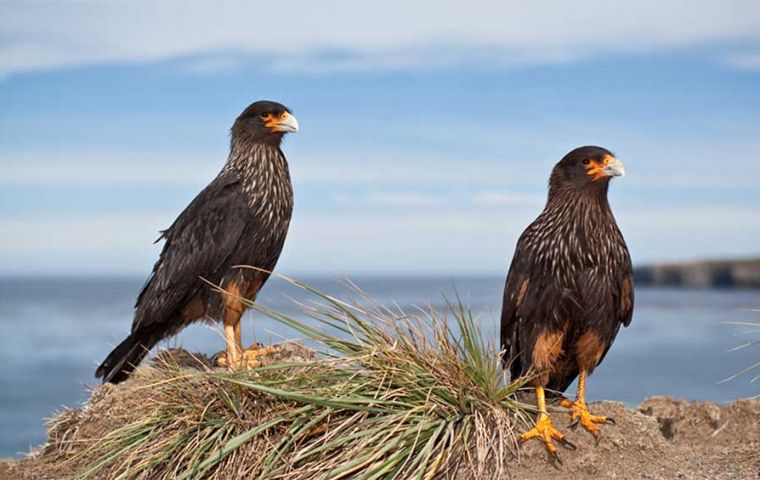MercoPress. South Atlantic News Agency
Falklands' Johnny Rook cognitive abilities break all records
 Caracaras in the Falkland Islands are fascinating and unique birds of prey, playing a significant role in the archipelago’s ecosystem.(Pic Burrard-Lucas)
Caracaras in the Falkland Islands are fascinating and unique birds of prey, playing a significant role in the archipelago’s ecosystem.(Pic Burrard-Lucas) A team of comparative cognition researchers at the Messerli Research Institute from the University of Veterinary Medicine Vienna, working with a colleague from Instituto de Investigaciones Marinas y Costeras, in Argentina, has found that a type of falcon can perform as well as Goffin's cockatoos (parrots) in solving puzzles to gain a food reward, a remarkable sign of avian intelligence.
In their study published open-access in the journal Current Biology, the group modified a puzzle box originally designed to test Goffin's cockatoos' problem-solving abilities to test those of the striated caracaras from the Falklands. The current article was partly reproduced at PhysOrg by Bob Yirka.
Striated caracaras live only on the Falkland Islands, at the southern tip of South America and Tierra del Fuego, where they are known locally as Johnny rooks. They are a kind of falcon, but do not act like other falcons, the researchers state. Instead, they act a lot more like kea parrots—a curious and intelligent parrot that lives in New Zealand. Such behavior made the research team wonder if the birds might do well with puzzle boxes.
By solving a puzzle box, a bird gains access to a treat. The boxes have been used as a means to test problem-solving abilities in several types of birds (and other animals)—and by extension, their intelligence. In this new study, the researchers obtained puzzle boxes created and used to test Goffin's cockatoos, which are known to be inquisitive and intelligent. The team modified the boxes to test birds with talons and sharp, bent beaks. Each puzzle box had eight puzzles, including dragging a door sideways, pushing a lever and tearing through a piece of paper.
The research team set the puzzle boxes out on an open parcel of land and waited. They noted that it only took a few minutes for the wild Johnny rooks to take notice. They watched as the birds systematically tried to solve the puzzles as a means to gain access to the treats, which were chunks of fresh red meat. No training was required.
The research team noted that 15 of the birds found the puzzle box and attempted to solve the puzzles—all 15 succeeded in solving at least one puzzle and 10 succeeded in solving all of them. The researchers noted that some of the birds solved some of the puzzles that none of the Goffin's cockatoos had been able to solve, and they generally solved them more quickly.
Caracaras in the Falkland Islands are fascinating and unique birds of prey, playing a significant role in the archipelago’s ecosystem. The most commonly found species there is the striated caracara, also known locally as the Johnny Rook. They are distinguished by their bold and curious nature. They often approach humans without hesitation, a trait unusual for birds of prey.
Adapted to the Islands' environment, caracaras in the Falklands exhibit a diverse diet. They are known to be opportunistic feeders, consuming everything from insects and carrion to stealing eggs and preying on small birds. This adaptability is crucial in the harsh and variable conditions of the islands.
The Falkland Islands provide an ideal habitat for caracaras, with vast open spaces and a lack of natural predators. This has led to a stable and healthy population of these birds on the Islands, unlike in other regions where their numbers have declined due to human activities.
Interestingly, the caracaras have become an iconic symbol of the Falkland Islands’ wildlife. Ornithologists and tourists alike love observing these unique birds in their natural habitat. Their role in the island’s ecosystem is vital. As scavengers, caracaras help in cleaning the environment by consuming carrion. They are also an integral part of the local culture and heritage. Caracaras’ presence is deeply intertwined with the history and natural landscape of the Falklands. There are reports of these birds curiosity and boldness in Charles Darwin's reports of his trip.




Top Comments
Disclaimer & comment rules-

-

-

Read all commentsThat's not a “Johnny Rook” in the accompanying picture. That's a Crested Caracara, “Johnny Rook” is the Striated Caracara.
Nov 23rd, 2023 - 08:06 am +1Are you sure that's not a sub-adult striated caracara (johnny rook)?
Nov 24th, 2023 - 02:45 am +1Even the young crested caracaras seem to have a lighter colored throat than these. But the colors could be different on a place like the Falklands. I've just been looking at some pictures.
That bird exists in a rough part of the world. I suppose the same could be said for Falkland Islanders.
Haha! Yesterday, MercoPress had a Crested Caracara as the lead image! Glad to see they changed it. Seems the editor does read what we post, after all!
Nov 24th, 2023 - 08:34 am +1Commenting for this story is now closed.
If you have a Facebook account, become a fan and comment on our Facebook Page!